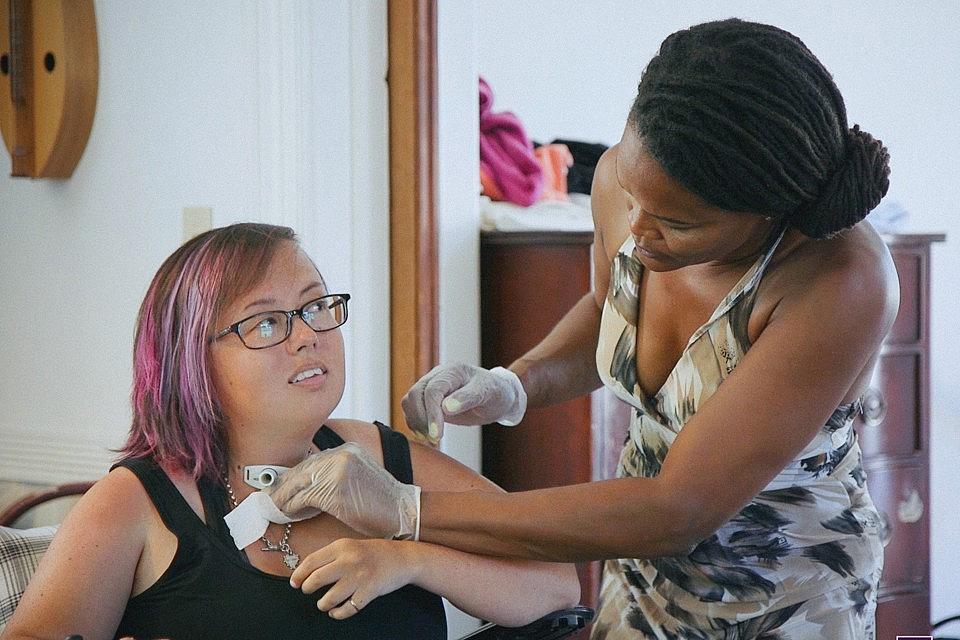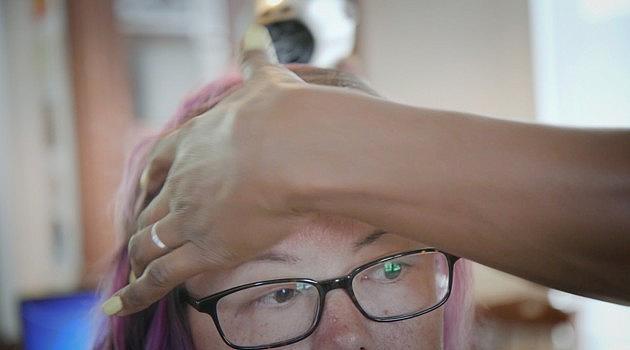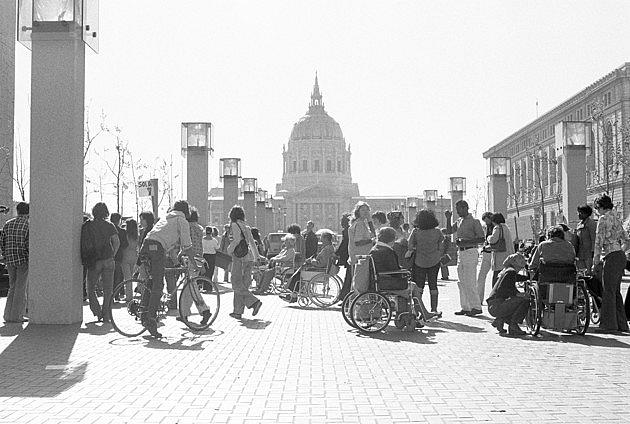Why Americans with disabilities fear Medicaid cuts
This article was produced as a project for the USC Center for Health Journalism’s California Fellowship.

Jeremy Raff / The Atlantic
On a recent Thursday afternoon, 43 demonstrators were arrested outside of Senate Majority Leader Mitch McConnell’s office. They shouted “No cuts to Medicaid!” as Capitol Police lifted some from wheelchairs and removed them from the building. The activists were quick to point out that the vans used to transport them were wheelchair accessible, which they attributed to decades of similar direct action.
“We’re here to fight for our freedom,” said Erik von Schmetterling, a demonstrator from Philadelphia, as he waited outside the police station for the others to emerge. It was humid and late in the afternoon. Schmetterling looked weary under his Philadelphia Eagles baseball cap. He had a blurry amateur tattoo of a person in a wheelchair on his forearm. It looked like the typical handicapped parking sign, but the figure’s arms were raised in victory above its head. “It’s us in the wheelchair, breaking the chains,” Schmetterling explained.
As Senate Republicans pick up their effort to repeal and replace the Affordable Care Act this week, the bill’s proponents insist that disabled people like Schmetterling have nothing to fear in their bill’s cuts to Medicaid, the federal health program for the poor, elderly, disabled, and children that now covers almost one in five Americans.
Patrick Toomey, who represents Schmetterling in the Senate, said the health-care proposal only “slightly slows down the rate at which Medicaid will continue to grow so that this is actually a sustainable program.” Medicaid has grown in recent years and now makes up almost 10 percent of federal spending. The bill’s supporters say the cuts protect funding for people who really need it, like Schmetterling, by limiting Medicaid for the able-bodied adults who became eligible under the Affordable Care Act, and limiting per-capita expenditures, to put it on a sound financial footing. The Senate’s bill would reduce the deficit by $321 billion over a decade.
But the proposed changes to Medicaid go well beyond a budgetary trim. Right now, more than 80 percent of Medicaid’s budget funds health care for the disabled, elderly, and children. The plan “fundamentally changes Medicaid in a way that hasn’t been done before,” said MaryBeth Musumeci, a Medicaid expert at Kaiser Family Foundation. The Senate bill would reduce Medicaid’s budget by a projected 35 percent over the next two decades, compared to current policy, and because so much of its budget already goes to the neediest Americans, Musumeci said it would have “profound implications for all beneficiaries.”
Stacey Milbern of Oakland, California relies on Medicaid-funded attendants to get out of bed, eat, bathe, and get around. (Jeremy Raff / The Atlantic)
That’s because such a large reduction leaves states little option but to raise taxes, pay doctors less, limit who gets coverage, cut back on services—or perhaps do all at once.
Some services, like hospital care and nursing homes, are mandated under federal law and can’t be cut. But advocates warn that because other services that are essential to disabled people are technically optional, they could be the first on the chopping block.
Chief among those optional benefits are the Medicaid-funded attendants who help about 3 million disabled Americans get out of bed, bathe, eat breakfast, drive to work, and go to sleep at night.
“When states are squeezed for money they are going to reduce those services or end them all together,” said Mary Lou Breslin, a policy analyst at the Disability Rights Education and Defense Fund, “and without that help they face institutionalization.”
Like a lot of people in the San Francisco Bay Area, Stacey Milbern got dressed in a plaid shirt, basketball shorts, and a Golden State Warriors cap on June 17. The basketball team had just won its second championship in three years, and earlier that week the streets along the team’s parade route were jammed with fans. An attendant who earns $12.50 an hour, Medicaid’s wage in Milbern’s area, tugged her shirt on and made sure her hat was angled just right.
Milbern had skipped the parade and was now celebrating in her own way instead. In her Medicaid-funded wheelchair, she rolled to a friend’s house almost two miles away. “It's not just about health care,” said Milbern, “it’s really about my ability to participate in society.” That night, another attendant would connect her to a respirator so she could sleep safely.
Milbern grew up in a military family in North Carolina. “I’m an Army brat,” she said. As a kid, her family handled most of her care, which worked well for a while. But then she began to “identify as queer,” which she feared would not sit well with her parents because they were evangelical Christians. She didn’t want to create tension in their relationship while she relied on them to eat, sleep, and use the bathroom. Instead, she retreated to the blogosphere under the alias Crip Chick. “It was everything I dreamed of, but it was all online,” she said. She plotted a move to the Bay Area, the home of the disability-rights movement.
* * *
Disability-rights activists protesting at 50 UN Plaza in April, 1977. (Disability Rights Education and Defense Fund)
By April 1977, the disabled were tired of waiting. Four years earlier, section 504 of the Rehabilitation Act had for the first time prohibited discrimination against people with disabilities, but the regulations to enforce the law had not been signed by the secretary of Health, Education, and Welfare. Disabled people held sit-ins across the country to demand enforcement.
In San Francisco, more than a hundred activists in wheelchairs, with walking sticks, and with hearing aides set up camp in the granite halls of the federal building at 50 UN Plaza. They lived, ate, and slept there for nearly a month, in what became the longest unarmed occupation of a federal building in U.S. history. They adapted sinks into makeshift showers, and the Black Panthers brought them lunch.
The room broke into applause. The secretary of Health, Education, and Welfare signed the regulations soon after the hearing. The activists’ victory “ultimately became the legal basis for the Americans with Disabilities Act,” said Breslin.
“The goal of the movement,” said Breslin, “was to enable people to live in the community.” Because Medicaid pays for more than half of the country’s in-home services, Breslin says it has been “the engine” for disabled people to live independently. “The fear now is a tremendous loss of hard won gains in the disability rights movement over the last four decades.”
* * *
Moving across the country is a pretty big deal for anyone, “but when you have a disability on top of it,” said Milbern, “it's terrifying to leave your only support system.”
Milbern chose the San Francisco Bay Area because it is “one of the most accessible places for people with physical disabilities.” But she said it's not just the infrastructure. Thanks in part to the section 504 activists, the Bay Area has long attracted disabled people from afar, which makes them a more visible presence. “Where I'm from, you don't see as many of us,” said Milbern. When she first arrived in Oakland, she went to a coffee shop and something felt weird. “I couldn't tell what was different until I realized that nobody was staring at me.”
Every year, California spends about $20,000 per person on non-elderly adults with disabilities, making it among the most generous states with its in-home care benefits. Advocates say that disabled people will feel cuts most sharply in states like Alabama, which spends about $10,000 per person every year, and which already limit access to such services.
But that is little comfort to Milbern, who says that moving back in with her family is not an option, and she couldn’t afford to pay for attendants out of pocket. “I feel so aware that I wouldn't be able to do anything without Medicaid,” said Milbern, who works in human resources at a bank. “I am only able to work because of my attendant support,” she said. “The health-care bill isn't just about health care.”
[This story was originally published by The Atlantic.]
[Photos by Jeremy Raff / The Atlantic.]

